-
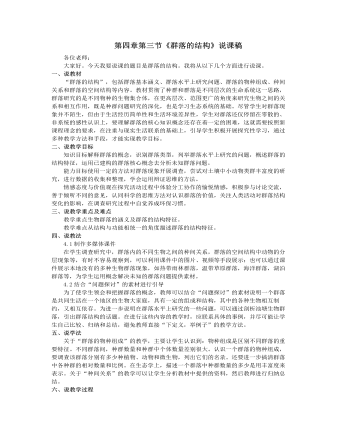
人教版高中生物必修3第四章第三节《群落的结构》说课稿
建构群落特征3群落有一定的空间结构,包括垂直结构和水平结构。思维拓展从结构与功能相统一的角度思考群落内的分层结构的意义。6.4运用群落核心知识概念解决未知群落问题学生已掌握了同一时间内聚集在一定区域中各种生物种群的集合是生物群落,所有群落都有一定的物种组成、种间关系、空间结构,不同群落主要表现在其具体特征上的差异。在此基础上,为学生提供新的问题情境,利用多媒体课件,展示不同生态环境下不同生物群落问题,让学生运用已建构的群落概念,通过分析、演绎和具体化等辩证思维的过程解决未知的群落问题,课件展示热带雨林、温带草原、海洋、湖泊等生物群落。学生运用概念说明不同的群落的物种丰富度差异,列举不同群落的种间关系,分析不同群落的垂直结构和水平结构,研究造成不同群落重要特征差异的原因。评价人类的活动对群落的结构的影响。
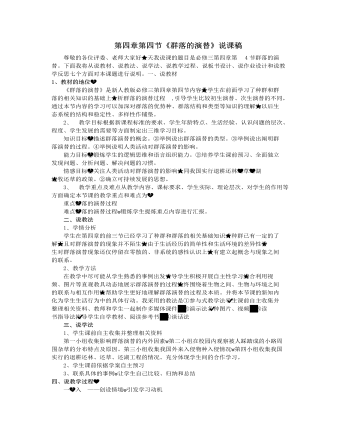
人教版高中生物必修3第四章第四节《群落的演替》说课稿
总结与大自然和谐相处走可持续发展道路。在我们的努力下地球一定能为我们人类提供更好的生存环境这部分的设计意图是培养学生综合实践能力把新知识内化为学生生活行为中的具体行动。五、说板书设计这样设计能直观形象地体现知识结构、突出重点难点、利于巩固新知识。六、说作业设计1、课本P80练习——常规作业主要为巩固和落实认知目标服务。2、活动与探究以“警惕外来物种入侵”为题写一篇科普文章。——开放性作业学生在自主完成任务的同时可以相互合作通过自主学习所获得的成果经共享共同整理、归纳、分类得到一种比较完整的答案。七、说教学反思1、本节教学过程主要重视运用“动态发展观”来组织实施教学用历史性的眼光从纵向进行寻踪综合利用视频、图片等直观教具动态地展示群落演替的过程帮助学生更好地理解群落演替的过程及本质。
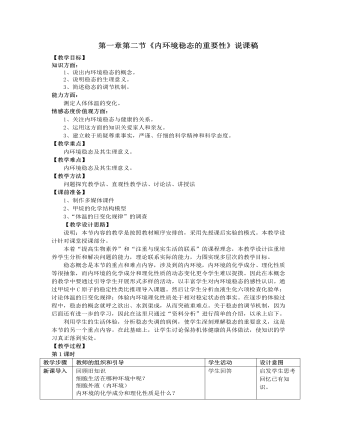
人教版高中生物必修3第一章第二节《内环境稳态的重要性》说课稿
四、稳态的重要意义 为什么内环境稳态失调后,会对机体造成危害?引导学生从细胞代谢需要的物质和条件进行分析,最后总结出:内环境稳态是机体进行正常生命活动的必要条件。如何预防内环境稳态失调、保持机体健康?引导学生从外界环境和机体自身调节能力两个方面去思考。即通过加强自我保健,减少外界环境变化对机体的不良影响,同时增强机体的调节能力以适应多变的外界环境。具体如何做?学生讨论,总结。1.保护我们的生存环境,防治环境污染。2.加强体育锻炼,增强体质,提高机体适应外界环境的能力。3.加强自我保健,为机体保持健康创造有利条件。尤其是处于比较恶劣的工作环境中的人,更应注意自身保健,如边防战士注意保暖、炼钢工人注意降温、抗洪战士注意补充水盐等。了解这些知识后才能懂得如何关爱自身和他人。
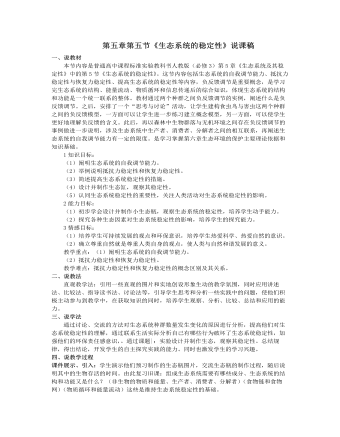
人教版高中生物必修3第五章第五节《生态系统的稳定性》说课稿
主要让学生明确以下观点:(1)自然生态系统是人类生存的基本环境;(2)人类活动的干扰正在全球范围内使生态系统偏离稳定状态;(3)人类生存与发展的命运就掌握在自己手中,但又受到自然规律的制约。反思总结,练习巩固:对本节知识点进行回顾,整理出简要的知识主线,为学生系统性复习巩固提供思路,课件展示老师课前收集准备的相关练习题,指导学生完成练习题,加学生深对本节知识的理解把握。结课布置作业:我们已经学习了生态系统的稳定性,那么,生态系统的各种功能之间的关系是怎样的呢?在下一节课我们一起来学习这一方面的内容。这节课后大家可以先预习这一部分,着重分析他们之间的关系。并完成本节的课后练习及课后延伸拓展作业。达到对本节内容知识的巩固提高和延展的目的。八、板书设计第五节生态系统的稳定性一、 生态系统的稳定性概念1.概念:生态系统所具有的保持或恢复自身结构和功能相对稳定的能力,
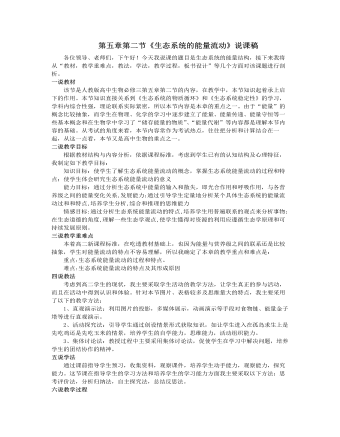
人教版高中生物必修3第五章第二节《生态系统的能量流动》说课稿
为使学生对知识达到深化理解、巩固提高的效果,我结合两个讨论题专门设计了一组即时训练题,做完后,屏幕展示汇总,以及时巩固新知。然后,进行当堂训练,这部分习题分AB两个层次,适合不同能力的学生做,做完后收上,课后批改后会了解学生掌握的情况,从而得到准确的学习信息。这部分用时约6分钟。三)结课组织学生总结本节课。引导学生可对照教学目标总结知识,从而尽快将知识形成能力;也可总结方法,从而理解生物学分析思路;还可以谈谈感想,从而理解人与自然的和谐相处的必要性。最后要求学生完成课后习题,课后时间允许的话还可组织有兴趣的同学进行对当地农田生态系统的能量流动情况得调查。这部分用时大约4分钟。七说板书设计生态系统的能量流动一概念:生态系统中能量的输入,传递和散失过程
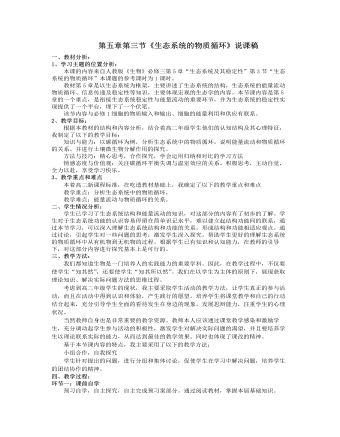
人教版高中生物必修3第五章第三节《生态系统的物质循环》说课稿
步骤四:展示点评、质疑探究展示小组展示讨论论成果,要求每组B、C层次学生进行展示。展示结束后由点评同学对展示结果进行点评,要求先点评对错;再点评思路方法和应注意的问题。既要有结论,又要有分析,力争有相关的总结和拓展。下面的同学注意倾听、思考,关键内容做好笔记,有补充或不明白的地方及时、大胆提出,力争全部过关,解决疑难点。根据学生点评结果,教师适当点评拓展。步骤五:拓展提升、总结升华简单扼要的课堂小结,系统回顾知识,强化学生对于生态系统物质循环的认识。环节三:课后检测布置训练内容,巩固知识。五、课后反思:本堂课采用我校163高效课堂模式,通过小组合作探究、展示自我、互相点评的方式完成整堂课的教学内容,充分突出了新课标中以学生为主体的指导思想。教学过程中,依据学生的个性差异,提出不同要求,布置不同任务,让不同层次的学生都能参与其中,调动全体学生的积极性,促进全体学生的发展。
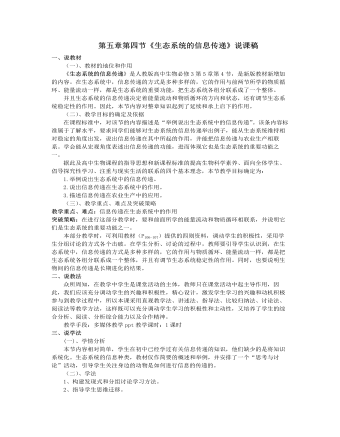
人教版高中生物必修3第五章第四节《生态系统的信息传递》说课稿
教师通过引导学生看课本的“资料分析”,要求学生从中得出生态系统中的信息传递在生态系统中的作用。学生通过分析、讨论可以得出结论,这时教师要适时的点拨,给予小结,并引导学生站在整个生态系统的角度去分析信息传递,并和能量流动、物质循环联系在一起,说明它们都是生态系统各组分必不可少的一部分,同时指出信息传递是长期的生物进化的结果。学生了解了生态系统中信息传递的作用后,教师适时进行话题的转移,“我们学习信息传递,是为了更好的利用它,谁能说出信息传递在我们生产和生活中应用方面的例子”?学生们这时就开始讨论了,他们可能做不出正确的回答,但他们却能举出生活中有关信息传递的许多例子。讨论几分钟后,让看看信息传递在农业生产中有哪些应用吧?使教学回归课本,使知识得以沉淀,形成自己牢固的知识体系。(依时可以安排学生自学)
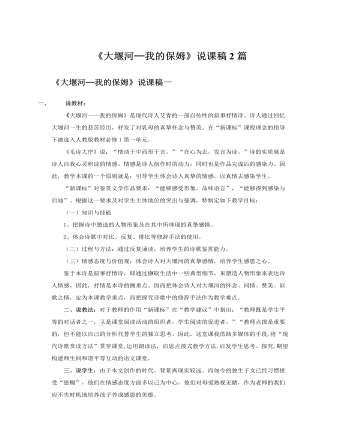
人教版高中语文必修1《大堰河─我的保姆》说课稿2篇
现代诗歌赏读方法四:美读(饱含讴歌与赞美情感再一次有感情地配乐朗读全文,对比前面的朗读,在读中加深情感的领悟。)(五)延伸拓展引进生活的源头活水,用情感来撞开学生的心扉。引导学生找到文章与现实的联系点,抓住这一联系点,让语文回归生活。我设计了“本诗哪些语段让你联想到自己的母亲?讲讲你和母亲的故事。”这个问题是把对大堰河的感情升华为对母亲的感情的过程。这样将语文学习的外延与生活的外延相等,把课文与生活有机地结合在一起。要求学生讲述条理清楚,语言生动。教师可以播放背景音乐,调动学生情感。这样,不仅锻炼了学生的口语表达能力,培养了学生感恩美德,同时也深化了本文的教学难点。现代诗歌赏读方法五:比读(投影出示孟郊《游子吟》比较两诗的异同,并有感情地朗诵。)(六)布置作业。把“你与母亲的故事”整理成一篇文章。

人教版高中历史必修2古代手工业的进步说课稿2篇
【教学方法】教法:讲授法、探究教学法、讲述法、谈话法、比较法学法:接受性学习法、探究性学习法、合作学习法、引导学生自主学习;通过阅读史料,分析历史问题;【教学重点】掌握中国古代手工业发展的基本史实:古代手工业的重要成就;官营手工业产品精美,品种繁多,享誉世界;民营手工业艰难发展,后来居上;家庭手工业是中国古代社会稳定的重要因素。【教学难点】中国古代手工业发展的特征。【教学媒体】多媒体、图片、视频【课型】综合课【导入新课】在05.7.13日伦敦佳士德的一场名为“中国瓷器、手工艺品及外贸产品的拍卖会上,一只绘有“鬼谷下山”图的元代青花瓷罐,被一美国古董商以1656万英镑也就是约2.45亿人民币的价格投得,为什么我们古代的手工业精品在今天如此受人青睐呢?这些价值连城的青铜器、瓷器是什么时候就产生了的,经历了一个怎样的发展历程?今天我们就来解开这些谜底。下面,我们一起学习第2课《古代手工业的进步》。
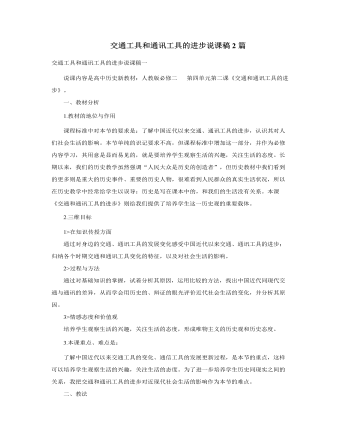
人教版高中历史必修2交通工具和通讯工具的进步说课稿2篇
师:改革开放后,乔家依然是生意兴隆,财源广进。下面我们来看一下他们乘坐另一种交通工具。(画外音响起,男中音用缓慢、低沉的语调朗诵;幻灯片展示)(七)乔致庸1905年来到上海,腰缠万贯的他坐上了行驶在柏油公路上的“四轮子”。可惜的是,此后的四十年,中国也没有多少柏油路和“四轮子”.直到50年后,四轮子和“柏油路”才多了起来。“四轮子”是什么?为什么“此后的四十年,中国也没有多少柏油路和四轮子”?为什么“直到50年后,四轮子和“柏油路”才多了起来”?生:略师:20世纪初,汽车开始出现在上海。因为旧中国政治腐败、民生凋敝。新中国成立后有了自己的汽车制造厂,比如说一汽、二汽。解放后,我们的汽车产业蒸蒸日上。(展示材料)屏幕显示:1956年,长春第一汽车制造厂生产出第一批 “解放牌”载重汽车,标志着中国汽车工业的诞生。2009年我国汽车工业取得了全球瞩目的成绩,首次超过美国,成为全球产销量第一的国家。
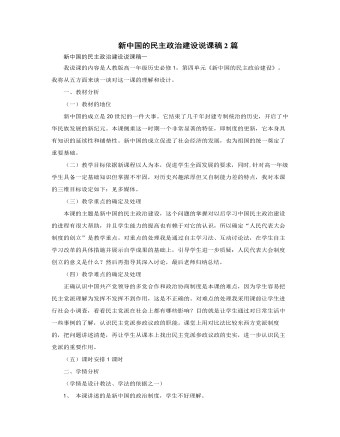
人教版高中历史必修1新中国的民主政治建设说课稿2篇
(一)教材的地位新中国的成立是20世纪的一件大事。它结束了几千年封建专制统治的历史,开启了中华民族发展的新纪元。本课侧重这一时期一个非常显著的特征,即制度的更新,它本身具有知识的延续性和铺垫性。新中国的成立促进了社会经济的发展,也为祖国的统一奠定了重要基础。(二)教学目标依据新课程以人为本,促进学生全面发展的要求,同时,针对高一年级学生具备一定基础知识但掌握不牢固,对历史兴趣浓厚但又自制能力差的特点,我对本课的三维目标设定如下:见多媒体。(三)教学重点的确定及处理本课的主题是新中国的民主政治建设,这个问题的掌握对以后学习中国民主政治建设的进程有很大帮助,并且学生能力的提高也有赖于对它的认识,所以确定“人民代表大会制度的创立”是教学重点。
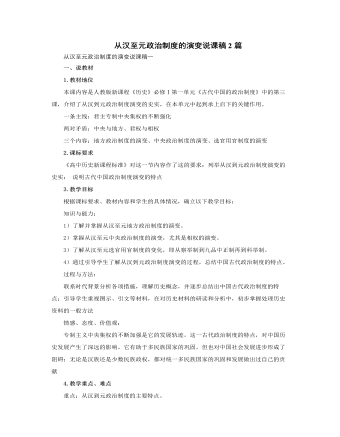
人教版高中历史必修1从汉至元政治制度的演变说课稿2篇
二、君主专制的演进(即中央政治制度的演变)通过地方政治制度演变的学习,掌握方法以后,以学生归纳整理基本线索为主,教师适当点拨,注意纠错。1. 汉承秦制,又有所变化。教师点拨强调继承与发展两个方面。创设情景:同学们看了电视连续剧《汉武大帝》后,知道汉武帝刘彻在继位之后,就急于对西汉王朝的政治制度进行改革。那么,西汉初期中央政治制度的基本框架是怎样的呢?汉武帝为什么要对它进行改革呢?改革后的西汉中央集权制度又是怎样的呢?请大家议一议,想一想。主干知识:西汉初期的中央政治制度的最大特点是“汉承秦制”。具体表现在两个方面:一是继续实行皇帝制度,维护皇权,这一做法也为后来各王朝所沿用;二是在中央设立三公,分别掌管行政、监察和军事。到汉武帝时,“中朝”成为西汉重要的中央决策机构,尚书令的权力日益重要,以丞相为首的三公九卿的权力被削弱,演化为执行机构。到了东汉光武帝时,进一步剥夺三公权限,扩大尚书的权力。

人教版高中历史必修1资本主义政治制度在欧洲大陆的扩展说课稿
1789年法国大革命后,共和派与君主派之间进行了长期反复的斗争,直到1875年法兰西第三共和国宪法通过才最终确立了共和政体,它为法国资本主义的进一步发展奠定了基础。专制色彩浓厚的普鲁士通过王朝战争这种自上而下的形式,完成了德国的统一。1871年德意志帝国宪法颁布,德国君主立宪政体确立,保留了浓厚的专制残余和军国主义传统。但资产阶级代议制的建立使德国的资本主义工业迅速发展起来,19世纪末跻身到世界强国行列。资本主义政治制度扩展到了欧洲大陆,随着这两个国家资本主义政治制度的确立,近代西方主要资本主义政治制度得以最终确立。四、板书一、法国共和政体确立的艰难历程1、艰难 (1)表现 (2)原因2、确立标志:法兰西第三共和国宪法

人教版高中英语必修4Body Language说课稿4篇
Textbook: Senior English for China (Book 4), by Liu Daoyi Time Allotment: 1 period (40 minutes)Date: March 20, 2014Teaching aids: blackboard, Multi-media, Power Point, chalk I. Text Analysis (教材分析)This unit is about body language, and the text selected in the reading part demonstrates the difference and similarity of body language in many parts of the world. Through learning this passage, students are required to raise their awareness of using body language in different parts of the world. As body language is closely related to our daily life, it is easy to arouse students’ interest in learning this text. Reading skills and speaking training are designed around the text.II. Teaching Objectives (教学目标)By the end of the lesson, students will be able to:1. Language Skill Objective(语言技能目标): develop reading ability (skimming and scanning)as well as speaking ability.2. Cultural Knowledge Objective(文化知识目标): know about the cultural differences of using body language.3. Affective Objective(情感目标): increase students’ awareness of using body language correctly in different cultures. III.Teaching Focuses and Difficulties(教学重点和难点)1. Teaching Focuses(教学重点): the difference and similarity of body language in many parts of the world.2. Teaching Difficulties(教学难点): develop students’ reading abilities of skimming and scanning and ask the students to show their opinions with fluent English.
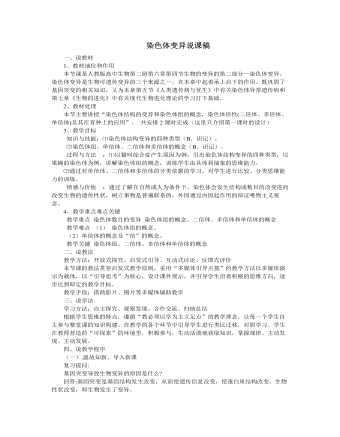
人教版高中生物必修2染色体变异说课稿
四、说教学程序(一).温故知新、导入新课复习提问:基因突变导致生物变异的原因是什么?回答:基因突变是基因结构发生改变,从而使遗传信息改变,使蛋白质结构改变、生物性状改变,即生物发生了变异。那么,基因是什么?它和染色体又有何关系?回答:基因是有遗传效应的DNA片断,染色体是DNA的载体,基因在染色体上呈线形排列。引出新知:对于一个生物体来说,正常情况下,其染色体的结构和数量都是稳定的。但在自然条件或人为因素的影响下,染色体的结构和数量均会发生改变,从而导致生物性状的改变,这就属于染色体变异。(二).把握重点、突破难点重点的把握:1、染色体结构的变异播放影片:猫叫综合征幼儿。让学生观察: 患儿哭声轻、音调高,很像猫叫。教师补充: 患儿的征状---两眼较低、耳位低下,存在着严重的智力障碍。阐述病因---染色体片段缺失

人教版高中英语必修1Journey Down the Mekong说课稿
2. let the Ss complete the forms paragraph by paragraph. Purpose here is to help Ss to get the habit of reading a passage as a whole, and pay attention to the organization of the text, as a result the Ss will fully understand the whole passage.3. ask Ss to retell the passage with the help of the key words in the form.Since the Ss in the class are in different levels, so I let them to fill in the blank to understand the meaning of the words and phrases better. ( That’s all for the while-reading. Now let’s move to the fifth step.)Step V: Post-reading (10mins) ---DiscussionIn this part students are asked to discuss in groups and list Wang Kun’s and Wang Wei’s attitudes about the trip. After that, Ss are encouraged to express their attitudes with the whole class. Collect their answers and don’t forget to praise them even if their answers may not be perfect.In this activity, discussion provides a vivid and active learning environment for Ss to communicate in English with newly learned language items. (Finally it comes to the homework.)StepⅥ: Homework (1min)1. Ss are required to read the text again after class and figure out the meaning of some complex sentences.2. Do the exercises on P19; This can help Ss to consolidate what they’ve learnt and make preparation for the next lessonPart4. Blackboard design.(说板书设计)On the top, there is the title of this lesson. On the left, there are main ideas for each paragraph. On the right, there are some new words and expressions.Unit 3 Travel journalJourney down the MekongMain idea of each para.:Para1: deciding to take a great bike trip along the Mekong river.Para2: Different attitudes between Wang kun and Wang wei.

人教版高中英语必修1Anne's best friend说课稿
Step 7 Language points 1.Vocabulary (1) go through (2) set down (3) a series of (4) on purpose (5) in order to (6)at dusk (7)entirely (8)face to face 2.Important sentences (1)…I’ve grown so crazy about everything to do with nature. (2)There was a time when … (3)I stayed awake on purpose until … (4)It was the first time … that I’d seen the night … (5)It’s no pleasure looking through … Purpose: 1.Master the required vocabulary and sentence structures. 2.Use them freely. Step 8 Consolidation 1.Find out the topic sentences 2.Retell the text according to the topic sentences Purpose: I want to know if my students understand the text. Step 9 Discussion Imagine you have to go into hiding like Anne and her family, what would you miss most? Giveyour reasons. Purpose: Train Ss’ oral English ability. Step 10 Homework Write an article on Friends. Purpose: 1. Improve the Ss’ writing ability. 2 Train the Ss’ ability of self—teaching and looking up information by themselves. Part 5 Blackboard design(说板书设计)Unit 1 Friendship Reading Anne’s Best Friend 1.Main idea of each paragraph: Para. 1 Anne made her diary her best friend. Para .2 Anne wrote her feelings in her diary. Para .3 Anne missed nature. Para.4 Anne saw the night face to face Para.5 Anne wanted to experience nature outdoors. 2.Listening: Exx.1 P3 3.Discussion: Exx.3 P3 Purpose: 1.Make Ss familiar with the passage 2.Make the design inductive, instructive and artistic.

人教版高中英语必修1English around the world说课稿
(3)v. 给:提出;展现,显现present sb. with sth. ; present sth. to sb. 把. . 交给;颁发;授予present sth. (for sth. )/present sth. to sb. e. g. Om his birthday, his friends presented him a collection of stamps. 在他生日时,他的朋友们送给他一套邮票作为礼物。The sword was presented by the family to the museum. 这家人把宝剑捐赠给了博物馆。The committee will present the final report to Parliament in June. 委员会将在六月向议会提交最后的报告。You need to present yourself better. 你需要更善于展现自己。It is essential that we present a united front. 至关重要的是我们要表现得更加团结。Step 4 ConsolidationT:Now that we have got a general idea of these words and phrases. Lets make up some sentences using them to master them. Suggested sentences:1. Your duties include typing letters and answering the telephone. 2. It is one of the greatest roles that she has played. 3. A large number of people have applied for the job. 4. The number of the panda is declining. 5. I'11 go there, even if I have to walk. 6. He came up to me to ask for a light. 7. The novel is about a family who can't communicate with each other. 8. He based his plan on interests of most people. 9. Why doesn't he make use of his singing talent?Step 5 Summary and homeworkT:Today we dealt with several new words and phrases. After class I hope that youcan read them again and again to keep them in mind. That's all for today. You aredismissed.

人教版高中英语必修1Nelson Mandela--A Modern Hero说课稿
In this step, give students a few minutes to read the passage . While they are reading, I will write some key words of the text on the blackboard. Then ask students to retell the passage according to the key words.By retelling, students can improve their ability of language organization and have an overall understanding of the article.Step 4 Group discussionIn this step, students will be divided into groups of 4 to discussion the following question: What qualities make a great person?After their discussion, invite a few groups to make a report to the class.This group discussion can practice students’ oral English and cultivate their abilities of cooperation and communication.Step 5. HomeworkLet students write a short passage to introduce a great person he or she admires.The homework can consolidate the knowledge the students have learned and cultivate their writing ability. Part 6 Blackboard Design(板书设计)That’s all my teaching procedures. Finally, I’d like to say sth about part 6 blackboard design. On the top is the title. On the left, there will be some new words and expressions. In the middle of the blackboard, I will write some useful sentence structures so that the students can know clearly what they’ve learned and then try to master the knowledge.OK. That’s all for my presentation. Thank you for your attention.

人教版高中英语必修2Cultural Relics说课稿2篇
Ⅲ. Analysis of the teaching material:The topic of this unit is cultural relics. Students are quite interested in topics about different cultures around the world. This is the second period of the whole unit. As a reading class, the passage mainly talks about the history of the amber room (how it was made, sent as a gift, lost and rebuilt).According to the new national curriculum, when teaching reading, much emphasis should be put on training the students’ reading skills.Ⅳ. Teaching objectives1. Language objectives:1) Students are required to master the key words and phrases occurred in the passage (e.g. amazing, decorate, belong, in return, less than etc.)2) Students are required to learn the attributive clause and acquire the sentence pattern.2. 1) Students are required to describe a certain thing by using the new sentence patterns.2) Students are required to master two kinds of reading skills—skimming and scanning, and learn to use them in their daily reading.3. 1) Students are required to know the history of the amber room.2) Students are required to appreciate cultural relics and understand the importance of protecting them.Ⅴ. Teaching important and difficult points1) the new words, phrases, and sentence pattern in the course of reading.2) Teaching difficult point: Help the students master two kinds of reading skills—skimmingand scanning and learn to apply them in daily use.Ⅵ. Teaching methods:Task-based method & Top-down model Ⅶ. Teaching aids: PPT, pictures, blackboard Ⅷ. Teaching procedure: